Some of the most common yellow frogs and toads of the world are found in tropical forests.
They can be yellow throughout the year or they can change into a vivid yellow color during the breeding season.
Yellow frogs and toads are generally rare in North America and highly present in warmer moist forests of Central America, South America, and Southeast Asia.
Table of Contents
Are Yellow Frogs Poisonous?
Many yellow frogs can be poisonous. From mildly poisonous to severely poisonous, these types of frogs can even kill humans.
Some of the most poisonous frogs and toads in the world can secrete sufficient skin poison to even kill small groups of people.
Many yellow frogs and toads of the world have been used by natives to make poisonous arrows. These arrows were either used in combat or against animals when out hunting.
Many yellow frogs and toads are poisonous only when eaten. Animals eventually learn to avoid these types of toads and frogs based on their vivid colors.
Some of the following yellow frogs and toads may seem small but they can easily kill people while others can be completely harmless to humans.
24 Yellow Frogs and Toads
Here are some of the most common yellow frogs and toads found around the world.
1. Pacman Frogs
Pacman Frogs are Horned Frogs native to South America. These frogs come in different colors and their hybrids are among the most common in captivity.
With a lifespan of up to 10 years, Pacman Frogs are long-living and come in 8 subspecies. They naturally inhabit areas of Brazil, Peru, Ecuador, Bolivia, Paraguay, and Venezuela.
- Albino Pacman Frog
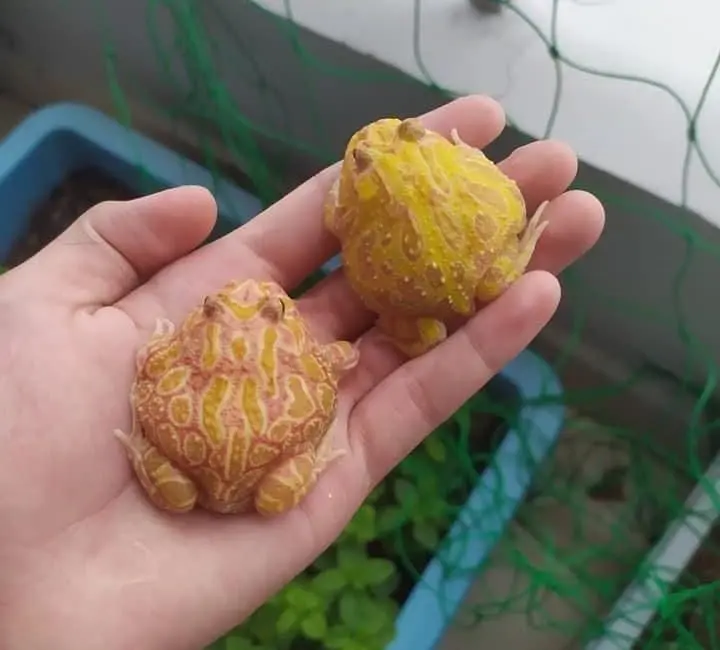
Large and yellow, The Albino Pacman Frog (Ceratophrys ornate) is one of the common Pacman Frogs in captivity.
This species should be handled with care as it can bite. Males grow to 4 inches while females reach a size of 7 inches.
Both males and females have a lemon-yellow color with a white underbelly.
Yellow nuance – bright yellow
- Yellow Fantasy Horned Frog

A cross between Brown Cranwell’s Frog and The Amazon Horned Frog, The Yellow Fantasy Horned Frog is also common in captivity.
Yellow, pale green, and pale brown colors are dominant in this species.
Also growing to a size of a few inches, The Yellow Fantasy Horned Frog should be handled with care due to its large sharp teeth.
Yellow nuance – bright yellow
2. Yellow Toad
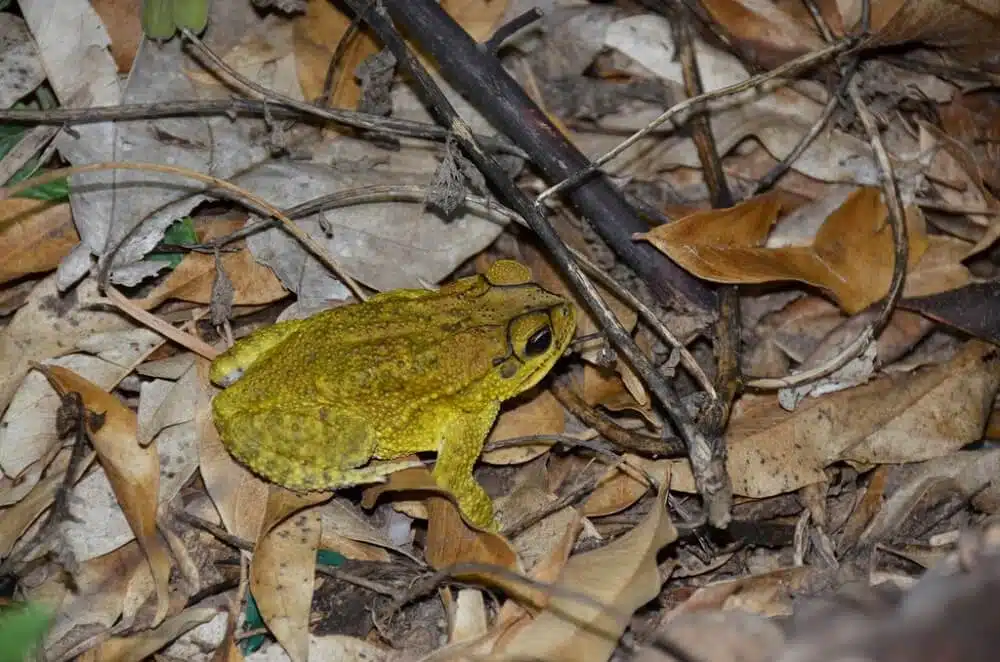
A Central American native, Yellow Toads (Incilius luetkenii) live in a widespread habitat between Costa Rica and Mexico.
This is a species that has high color variations, from solid colors to a patterned appearance.
Yellow Toads come in a bright yellow or mustard-yellow nuance with a uniform dorsal appearance.
The appearance of Yellow Toads is highly dependent on seasons. Male toads are more likely to be seen in a yellow nuance.
Male toads change colors into the rainy season while females don’t. Males and females have a similar duller coloring outside of the rainy season.
It’s during the rainy season that males also show high levels of aggression between them.
Its warty skin shows a bright yellow or dark yellow color while the ventral side is normally white.
Other morphs include a green-yellow toad and an olive and yellow morph. All of these morphs are specific to dry areas or dry woodlands.
Yellow nuance – bright yellow, mustard-yellow
3. Lesueur’s Frog

High color variation is specific to the male Lesueur’s Frog (Ranoidea lesueuri). This is a species that comes in a dark or bright green color and then turns yellow for the breeding period.
Male frogs of this species measure just over 1 inch and may turn completely or partially yellow.
Some of the instance when it only partially turns yellow additionally shows a large green patch on the dorsum with or without black spots.
Found in streams of Southeastern Australia, Lesuer’s Frog additionally transitions into a yellow-green morph in the breeding season.
An albino pale yellow to white color is also specific to the male of the species.
Yellow nuance – bright yellow, yellow-green
4. Yellow Tree Frog

A mostly yellow appearance is specific to the Yellow Tree Frog (Dendropsophus microcephalus). Along with its variable yellow nuances, this is a frog with variable sizing as well.
Males of the species have never reached 1 inch while females are slightly larger, growing to 1.2 inches.
Dark yellow nuances are specific to its dorsum while pale yellow to white colors are seen on its ventral side.
Males of the species may also show brown lines across their dorsum or they main remain uniform in coloring.
Known for their yellow-bronze eyes with black pupils, Yellow Tree Frogs are an arboreal species specific to South American forests.
Yellow nuance – dark yellow, bright yellow, yellow-bronze
5. Golden Poison Frog

A colorful frog with multiple morphs, Golden Poison Frogs (Phyllobates terribilis) are now declining in numbers in their native Colombian forests.
These types of frogs have a bright pattern-free appearance. They show a main yellow color with a bright appearance.
Furthermore, all of its other variants are also bright. There’s a rare mint (bright green) form of the species as well.
Orange morphs are also common.
Yellow, orange, and mint Golden Poison Frog morphs come with contrasting black eyes.
These frogs aren’t always colorful. Initially black, they only become colorful once reaching breeding age.
While small, the Golden Poison Frog is considered highly poisonous and the most poisonous frog according to some sources.
A single frog of the species can kill multiple humans.
Yellow nuance – bright yellow
6. Indian Bullfrog

A very large type of bird, Indian Bullfrogs (Hoplobatrachus tigerinus) are among the most common species with a bright yellow color.
This species is normally green, olive, gray, brown, and different other color combinations but turns yellow into the breeding season.
The male is known for its 2 large vocal sacs which are blue, and not yellow as the rest of the bullfrog.
As one of the largest frogs in Asia, Indian Bullfrogs grow to a size of almost 7 inches and eat all types of prey, including small birds.
These types of frogs have high color variation from one area to another. While Indian natives, they are also spotted in neighboring countries of Bangladesh, Nepal, and Pakistan.
Yellow nuance – bright yellow, yellow-green
7. Yellow-banded Poison Dart Frog

Aposematic frogs have highly contrasting colors which are meant to scare predators away. Yellow-banded Poison Dar Frogs (Dendrobates leucomelas) are among the most common aposematic frogs in South America.
Black and yellow colors dominate their appearance. These frogs have a black body with yellow wavy bands.
These bands are decorated with black spots essentially creating aposematic black and yellow coloring.
These poisonous frogs are dangerous to humans. They eat various insects and absorb their toxins.
In direct contact with humans, these secreted toxins can even lead to cardiovascular problems and death.
Yellow nuance – bright yellow
8. Panamanian Golden Frog

A species native to Panama, The Panamanian Golden Frog (Atelopus zeteki) is found along the country’s forests.
Yellow nuances dominate the multiple appearances of this species. Golden yellow nuances are frequent, followed by pale yellow and yellow-green nuances.
The Panamanian Golden Frog may be entirely yellow as it can also be yellow and black.
Its black dorsal patterns may be seen in the form of dots, also covering its legs.
A species active during the day, the frog is arboreal and may also come out for food at night.
Absorbing toxins through prey, the frog is poisonous to humans and animals. Its high toxicity levels have been leveraged by local warriors for traditional hunting weapons.
Yellow nuance – golden yellow, pale yellow
9. Dwarf Mexican Tree Frog

Small but poisonous, Dwarf Mexican Tree Frogs (Tlalocohyla smithii) are endemic to the wetlands and forests of Mexico.
High color variability is characteristic of a species that is almost always bright in appearance.
Dwarf Mexican Tree Frogs rely on colors, poison, and fleeing to stay safe in front of potential predators.
These types of frogs are still found in high numbers, even if their populations may be diminishing.
They can be identified by their yellow colors but they also come in orange, green, and pale yellow nuances.
Dwarf Mexican Tree frogs can have spots on the back, particularly on the brighter morphs.
Yellow nuance – yellow-orange, pale yellow
10. Hay’s Snouted Tree Frog
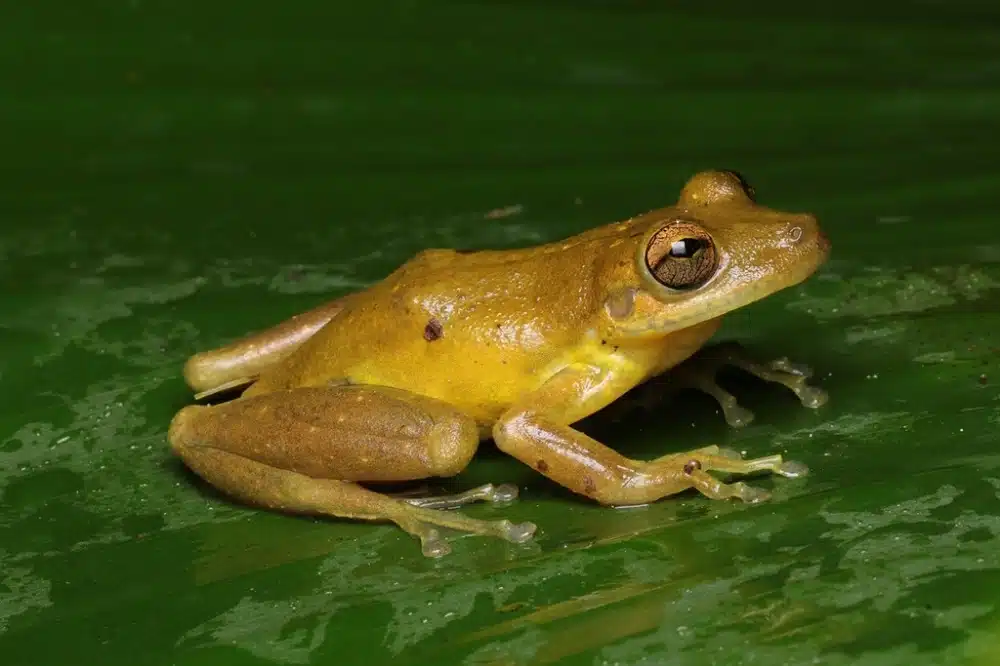
A small species of tropical forests, Hay’s Snouted Tree Frogs (Scinax hayii) grow to a size of up to 1.5 inches in the case of females and 1.3 inches in the case of males.
A golden-yellow morph is confirmed for the species. It also comes in a green morph with yellow spots on the legs as well as in a green morph without yellow spots.
Dark green and bright green morphs are also noted for this species.
Hay’s Snouted Tree Frogs also appear in an olive-green dorsum with a yellow ventral color combination.
Yellow nuance – golden yellow
11. Burmeister’s Tree Frog

Yellow and yellow-orange morphs are specific to the otherwise green Burmeister’s Tree Frog (Boana prasina).
Its morphs are generally spotless with only the green morph showing yellow lateral stripes.
Its yellow-orange morph shows a darker yellow nuance, closer to orange, on the dorsum.
The pale yellow morph shows uniform coloring across the back and the legs.
Some other rare Burmeister’s Tree Frog morphs with yellow coloring also exist. A brown Burmeister’s Tree Frog with deep yellow ventral coloring exists.
These poisonous frogs still live around Brazil’s deep woodlands.
Yellow nuance – bright yellow, yellow-orange, yellow-brown
12. Coorg Yellow Bush Frog

A specialized type of frog found in India, The Coorg Yellow Bush Frog (Raorchestes luteolus) is among the species that comes in different yellow nuances.
This type of frog is only found around local coffee plantations where it takes on the colors that best suit its camouflaging needs.
From pale yellow to yellow-sand nuances, this is a species with some of the pales types of markings which are barely visible across its dorsum.
Often seen in orange and brown morphs, this flattened shape species also comes in different pale yellow nuances.
Most of its yellow morphs come with fine black or dark brown dorsal spots.
Yellow nuance – pale yellow
13. Variable Clown Tree Frog

Reaching a size of around 1 inch, The Variable Clow Tree Frog (Dendropsophus triangulum) is one of the most variable patterns of yellow frogs in the world.
This species shows a uniform yellow color but it also comes in a yellow nuance with brown patterns.
These patterns vary from just 2 brown spots behind its head to a large brown band across its mid-dorsum.
A yellow morph with multiple tiny brown dots across the back and legs are also specific to this species.
As the species changes appearance, it may also show dark yellow patches on its brighter yellow base color.
Yellow nuance – bright yellow, golden yellow
14. Marbled Balloon Frog
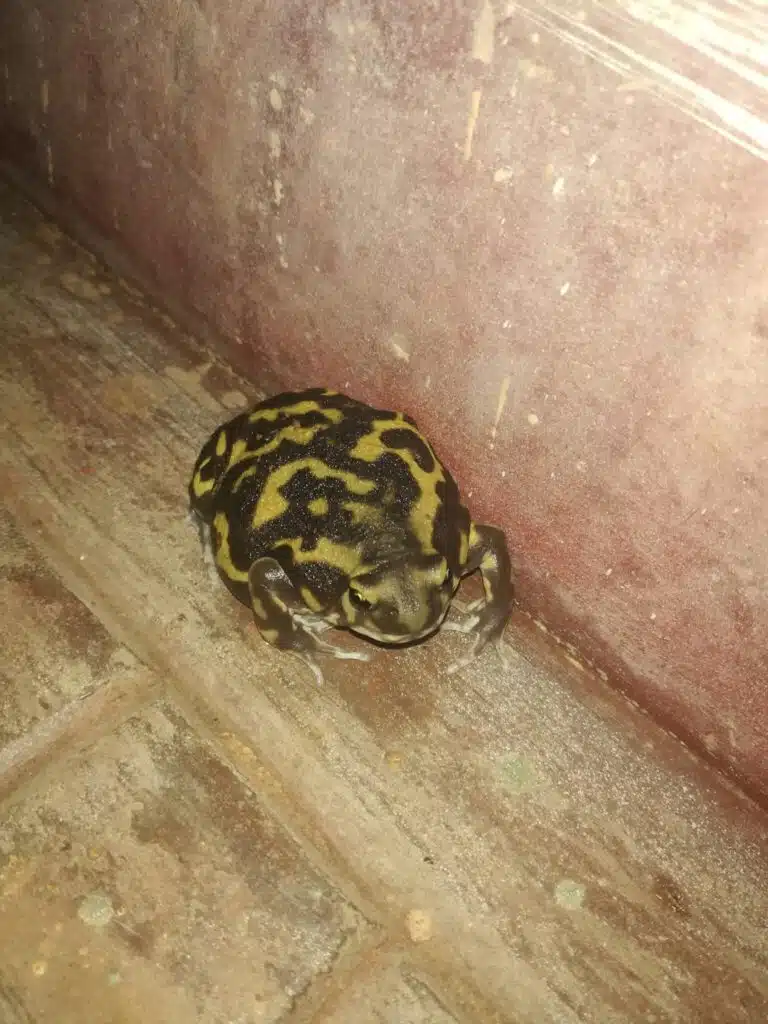
A marbled appearance inspires the name of this Asian family of frogs.
From a black appearance with yellow wave-shaped dorsal patterns to a yellow appearance with dark gray patterns, this type of frog comes in varying color combinations.
Reaching a maximum size of up to 2.5 inches, Marbled Balloon Frogs (Uperodon systoma) are also named after their inflated balloon-like shape.
An Indian native, this frog spends its time underground coming out in the rainy or monsoon season.
Yellow nuance – bright yellow, yellow-green
15. Harlequin Treefrog

An arboreal species, The Harlequin Treefrog (Dendropsophus ebraccatus) is among the common yellow species of Mexico, Costa, Rica, and Panama.
Both males and females have similar colors but females are considerably larger.
Golden yellow dominates the base color of its various morphs. Its bright yellow appearance is backed by brown or red-brown dorsal patches.
These are seen both across its back and across its legs.
The arboreal species additionally shows yellow spots on the brown segments or patterns across its dorsum.
Yellow nuance – golden yellow, yellow-orange
16. Upper Amazon Tree Frog

A common species in disturbed habitats, The Upper Amazon Tree Frog (Dendropsophus bifurcus) is native to South America and Central America.
This is a species with yellow and brown nuance combinations with brown being the dominant color across most morphs.
Bright brown to tan sections are seen on its lower body while its upper body shows darker brown sections.
Yellow bands run along the sides of its body. Their heads are also mostly yellow or golden-yellow.
Yellow nuance – bright yellow, golden yellow
17. Pumpkin Toadlet

A species secreting a potent neurotoxin, the small Pumpkin Toadlet (Brachycephalus ephippium) is a species with yellow-orange or orange coloration.
Its morphs show uniform coloring free of stripes, spots, or other types of brighter or darker marks.
The eyes of the toadlet are black while its ears are not fully developed and not capable of hearing.
This is a species that still calls but which relies on visual cues to attract mates.
Endemic to Brazil, the Pumpkin Toadlet is small, rarely reaching a size of up to 1 inch.
Yellow nuance – yellow-orange
18. Robust Kajika Frog
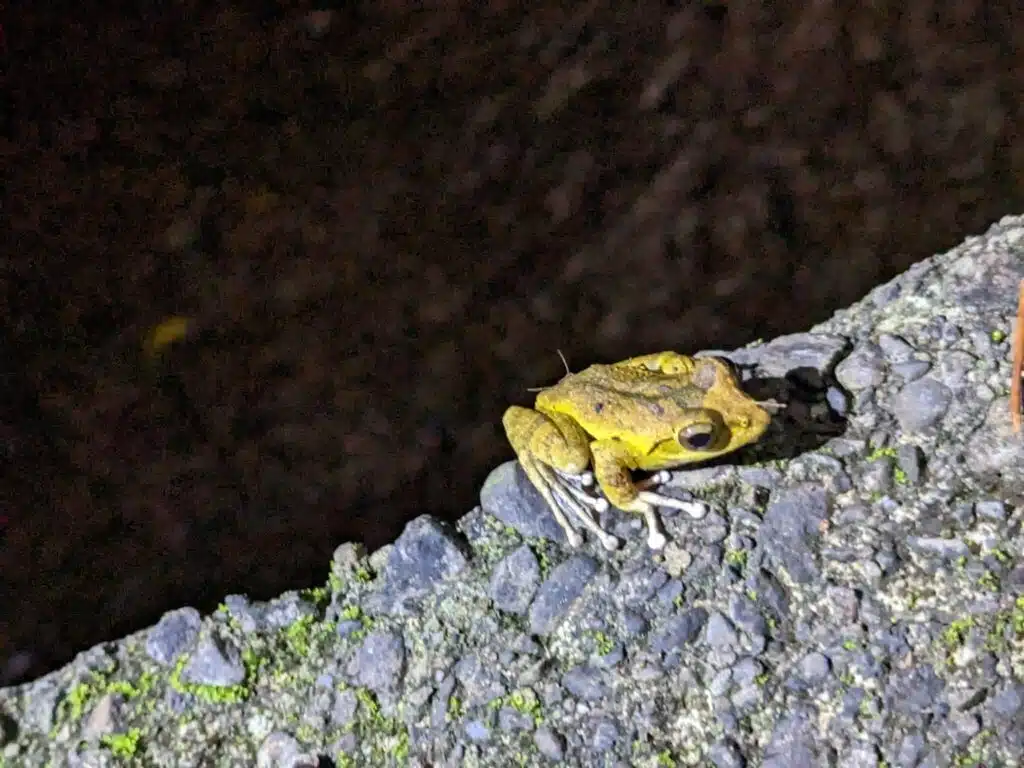
Found along Taiwanese streams and rivers, Robust Kajika Frogs (Buergeria robusta) also come in a yellow morph.
A multicolored species, the frog has a yellow or yellow-green color. It shows a flattened body shape with large eyes and uniform yellow coloring.
This frog species is also highly variable in coloring with males taking on a more yellow nuance during the breeding period.
Females are darker and larger. A female Robust Kajika Frog can even be almost twice as large as a male.
Yellow nuance – bright yellow, yellow-green
19. Yellow Cururu Toad

Male Yellow Cururu Toads (Rhinella icterica) are mostly yellow, yellow-green, or yellow-brown.
Smaller than females, these South American frogs often come with dark brown spots or black spots on the dorsum.
Darker and larger females may also show yellow sections around the mouth.
This is a species that also feeds on yellow prey. Growing to a size of over 6 inches, Yellow Cururu Toads can even eat yellow scorpions (Tityus serrulatus) as they show immunity in front of this prey’s venom.
These frogs can even shoot their poison into the prey to quickly subdue a large number of animals and bugs.
Yellow nuance – bright yellow, yellow-brown
20. Almendariz’s Tree Frog
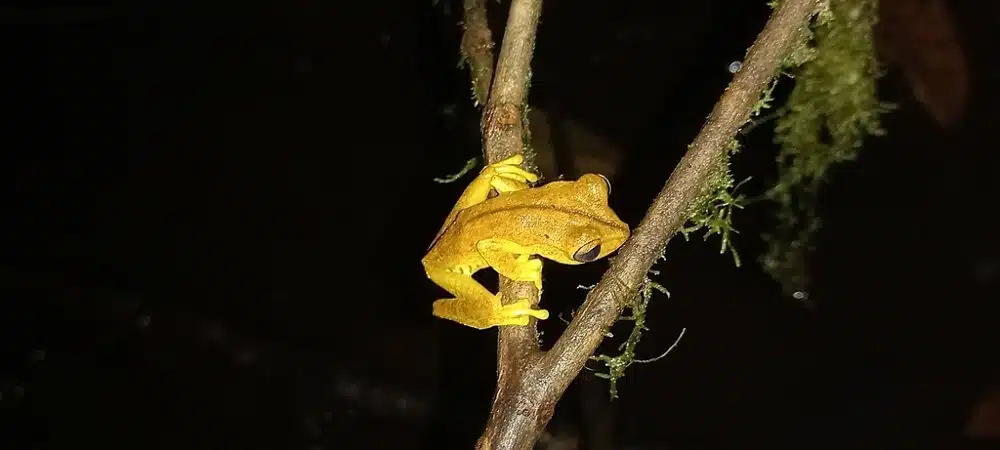
An Ecuadorian frog, Almendariz’s Tree Frog (Boana almendarizae) is a yellow arboreal frog with a poisonous nature.
It comes in different yellow color patterns which are seen across males and females.
A mostly yellow-orange dorsal color is combined with bright yellow lateral colors and a black mid-dorsal line.
A more colorful patterned morph includes a yellow-orange dorsum, yellow legs, and yellow bands across the legs and dorsum. This morph also comes with a distinctive black stripe along the dorsum and the head.
Brown morphs also exist. They come with black and yellow bands across the legs and the sides.
Yellow nuance – bright yellow, yellow-orange
21. Imbabura Tree Frog

Tropical forests of Colombia and Ecuador are home to the Imbabura Tree Frog (Boana picturata).
This is a species that comes in different yellow morphs and may also exhibit yellow eyes alongside mint-green eyes.
A yellow-dominant morph with brown patterns is seen across tropical woodlands. This is also a species with a brown-dominant color with yellow spots.
Brown nuances on the frogs vary from dark brown to red-brown or brown-black.
This last morph also features vivid yellow ventral coloring of a uniform nature.
Reaching a size of up to 2.1 inches, Imbabura Tree Frogs also come with a green and black morph without any yellow sections.
Yellow nuance – bright yellow, pale yellow
22. Venezuelan Yellow Frog

A species endemic to Venezuela, The Venezuelan Yellow Frog (Atelopus carbonerensis) is largely absent from its habitat most times of the year.
This is a species that only lives along streams and temporary bodies of water at high elevations, which makes it even more secretive.
A mostly yellow appearance is specific to these frogs. Some red or orange nuances are seen across its yellow dorsum.
Unlike other species, the ventral color of the Venezuelan Yellow Frog is patterned and not uniform. Black and yellow colors are specific to its ventral side.
The over-reliance of the species on temporary streams and rivers may be one of the reasons for its fast-declining populations.
Yellow nuance – golden yellow, yellow-orange, yellow-brown
23. Zimmermann’s Poison Frog

A species that feeds on ants, termites, bugs, and even on its tadpoles, Zimmermann’s Poison Frogs (Ranitomeya variabilis) have a multicolored appearance that varies according to its range.
Found in Peru, Ecuador, and Colombia, these frogs often come in yellow, green, and black colored patterns.
The species is dominated by large black spots across its body and legs. The spaces between these spots can be yellow towards the head and green on the dorsum. Its lower body and legs may be blue.
Also found in Western Brazil, this species has atypical breeding patterns as well.
Males who are dominant towards their territory also show paternal care toward their young. Females aren’t known for taking care of the young, a task that males are responsible for.
However, both males and females are cannibalistic. They can eat their young both once emerged and in the egg stage.
Yellow nuance – bright yellow
24. Dyeing Poison Dart Frog

A species of The Amazon and Northern South America, Dyeing Poison Dar Frogs (Dendrobates tinctorius) are poisonous and often yellow.
These frogs are poisonous to all types of animals if eaten.
They show at least several morphs with vivid yellow coloring. In most cases, the frog is black with yellow upper dorsum coloring that may or may not show additional black spots.
A yellow, black, azure, and navy morph is also specific to this species.
Other common variants show a mostly pale yellow color of the dorsum with a central black stripe and additional lateral black stripes with blue legs.
Atypical patterns are characteristic of the species which may also show a fully black body with yellow stripes, dots, and marks.
Males and females have similar colors but females are larger.
Yellow nuance – pale yellow, bright yellow, golden yellow